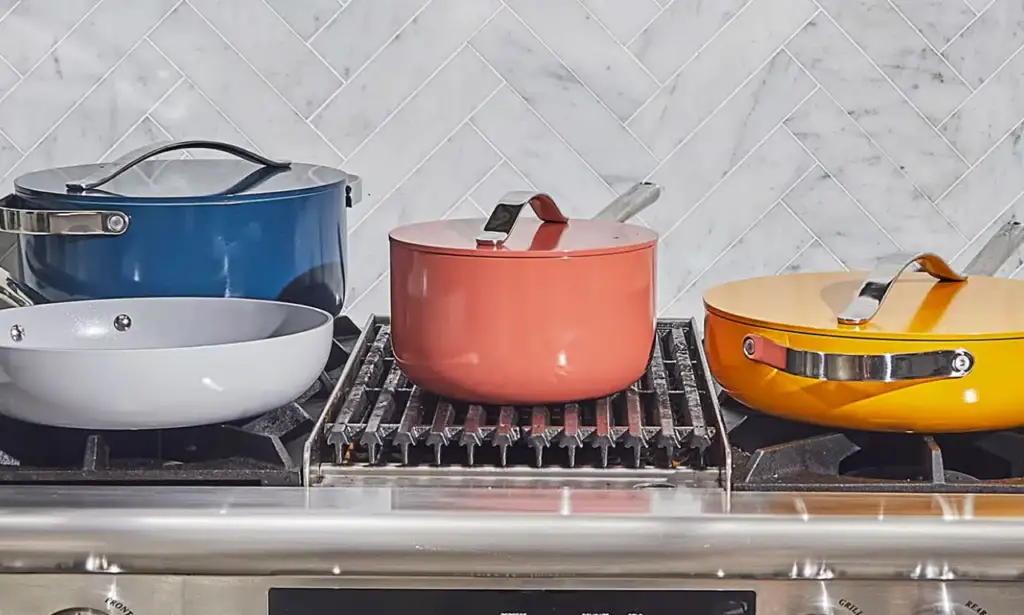Reviewed by Godfrey Ogbo
The non-toxic induction cookware materials that are a must-have in every sustainable kitchen are stainless steel, cast iron, glass, etc.
In an era where sustainability is gaining traction, the choices we make in our kitchens matter more than ever. One significant shift has been towards induction cooking, praised for its energy efficiency and precision.
However, the non-toxic induction cookware you choose can either amplify its eco-friendly benefits or negate them.
What is Induction Cooking?

Induction cooking is a marvel of modern technology. Induction cooktops heat cookware using electromagnetic fields rather than direct heat like conventional gas or electric stovetops do.
They offer rapid heating, precise temperature control, and superb energy efficiency. But what truly sets induction apart is its eco-friendly nature—it generates heat directly in the pan, wasting minimal energy.
To fully utilize induction’s ecological potential, however, non-toxic cookware must be used together with it.
What Kind of Cookware is Best for Induction Cooking?
Cookware made exclusively for induction cooktops is the best kind of cookware for induction cooking. Cookware that is magnetic and effectively conducts heat using induction technology is required for induction cooktops.
The following are some of the top non-toxic induction cookware varieties for induction cooking.
Stainless Steel
This is one of the most widely used options for induction cooking. As not all stainless steel is suitable, look for cookware with a magnetic bottom.
Cast Iron
Cookware made of cast iron, such as cast iron skillets and Dutch ovens,works well with induction cooktops. Cast iron holds heat effectively and is naturally magnetic.
Enamel-Coated Cast Iron
On induction cooktops, you can also utilize cookware like skillets or Dutch ovens made of enamelled cast iron. Thanks to the enamel layer, acidic food interactions are less likely.
Carbon Steel
Carbon steel conducts heat well and is magnetic, like cast iron. Pans made of carbon steel perform well on induction cooktops and are excellent for high-heat cooking.
Induction-Ready Cookware
Some cookware is specifically labelled as “induction-ready” or “induction-compatible.” These are designed to work seamlessly with induction cooktops.
Clad Cookware
Clad cookware consists of multiple layers of metal, often including magnetic stainless steel, which makes it suitable for induction cooking. Examples include tri-ply or multi-ply stainless steel pans.
Induction Discs
Suppose you have non-induction-ready cookware that you want to use on an induction cooktop. In that case, you can purchase induction discs (also known as induction interface discs) that provide the magnetic surface necessary for induction heating.
Remember to check the manufacturer’s label or product description to ensure that the cookware is compatible with induction cooktops.
Induction cooking offers precise temperature control and energy efficiency, making it a popular choice for many home cooks, so investing in the right cookware is essential for optimal performance.
Toxic Cookware Materials To Avoid And Their Health Impacts
Avoiding toxic cookware materials is essential for your health. Here are some of the most toxic materials to steer clear of and their potential health impacts:
Non-Stick Cookware (Teflon)
When overheated, non-stick coatings can release toxic fumes containing perfluorooctanoic acid (PFOA), which has been linked to health issues like flu-like symptoms (Teflon flu), and long-term exposure may have more severe health effects.
Aluminum
Excessive exposure to aluminium may be associated with neurological disorders and has been studied in relation to Alzheimer’s disease. Acidic foods can react with aluminium, causing it to leach into your food.
Copper
Consuming excess copper can lead to gastrointestinal distress and other health issues. Unlined copper cookware can release copper into food, especially when cooking acidic dishes.
Non-Anodized Aluminum
Like copper, regular aluminium can react with certain foods, leading to aluminium ingestion, which may have health implications over time.
Low-Quality Non-Stick Coatings
Poorly made non-stick coatings may contain harmful chemicals that can leach into your food. Always choose cookware with reputable, non-stick coatings.
Lead-glazed ceramic or Pottery
Lead from glazes can leach into food and lead to lead poisoning, which can have severe health consequences, particularly in children.
Cheap or Unlabeled Cookware
Cookware made from unknown materials or low-quality materials may contain hazardous substances that can potentially leach into your food.
What are Some Non-Toxic Induction Cookware Materials?
Choosing non-toxic induction cookware material depends on your preferences and cooking needs. Here are Eight relatively low-toxicity cookware materials, along with their pros and cons.
1. Stainless Steel
Pros: Durable, non-reactive, resistant to rust and staining, and does not leach chemicals into food.
Cons: Poor heat conductivity (unless layered with aluminum or copper), food can stick without proper seasoning, and it can be relatively heavy.
2. Cast Iron
Pros: Excellent heat retention and distribution, naturally non-stick when seasoned, add iron to your diet, and long-lasting.
Cons: Requires regular seasoning and maintenance, can be heavy, and may react with acidic foods if not correctly seasoned.
3. Ceramic
Pros: Non-toxic, non-reactive, and doesn’t leach chemicals, heat evenly, and retain heat well.
Cons: It can be fragile and prone to chipping or cracking, may require special care, and can be relatively expensive.
4. Glass
Pros: Non-reactive and doesn’t leach chemicals, great for baking and see-through cooking, and easy to clean.
Cons: Can break if exposed to rapid temperature changes or impact; not ideal for stovetop cooking.
5. Anodized Aluminum
Pros: Harder and more durable than regular aluminum, resistant to scratching and corrosion, and provides even heating.
Cons: Expensive compared to regular aluminum, not entirely non-stick, and may not last as long as cast iron or stainless steel.
6. Carbon Steel
Pros: Similar to cast iron but lighter, excellent heat retention and distribution, naturally non-stick when seasoned.
Cons: Requires seasoning and maintenance, can rust if not dried properly after use, and can be heavy.
7. Enamel-Coated Cast Iron
Pros: Combines the benefits of cast iron with a non-reactive enamel coating, easy to clean, and retains heat well.
Cons: Enamel can chip or crack with rough handling and may not achieve the same level of seasoning as bare cast iron.
8. Silicone
Pros: Safe for baking, flexible, non-stick, and easy to clean.
Cons: Not suitable for all types of cooking, may not provide the same searing or browning as other materials, and relatively limited in use.
20 Buying Considerations To Help You Make The Right Cookware Choice
Here are purchasing tips to help you make the right non-toxic induction cookware choice, including options for various cooking needs and budgets.
1. Budget
Determine your budget range before shopping for cookware to narrow down your options.
2. Material
Select a material that goes hand in hand with your cooking technique (e.g., stainless steel, cast iron, non-stick, etc.).
3. Heat Conductivity
Consider how evenly the cookware distributes heat for consistent cooking results.
4. Non-Stick vs. Traditional
Decide between non-stick surfaces for easy release or traditional surfaces for searing and browning.
5. Durability
Invest in cookware that will last over time, especially if you cook frequently.
6. Maintenance
Consider how much maintenance and seasoning different materials require.
7. Weight
Think about the weight of the cookware, especially if you need something lightweight or easy to handle.
8. Oven Compatibility
Check if the cookware is safe for use in the oven and up to what temperature.
9. Stovetop Compatibility
Ensure the cookware is compatible with your stovetop (induction, gas, electric, etc.).
10. Size
Select a range of cookware sizes to accommodate various cooking needs.
11. Lids
Check if lids are included and if they fit tightly to trap heat and moisture.
12. Handles
Consider the handle design for comfort and safety, especially for oven use.
13. Cooking Style
Think about the types of dishes you frequently prepare (e.g., stir-frying, braising, baking) and choose cookware accordingly.
14. Ease of Cleaning
Assess how easy it is to clean the cookware, especially if it’s dishwasher safe.
15. Health and Safety
Ensure the cookware is free from harmful chemicals like PFOA and PTFE.
16. Brands
Explore brands that don’t compromise on quality and the consumer’s happiness.
17. Warranty
Check if the non-toxic induction cookware comes with a warranty to protect your investment.
18. Reviews
Read product reviews and recommendations from other users.
19. Multipurpose
Look for versatile cookware that can be used for a variety of dishes.
20. Sets vs. Individual Pieces
Decide whether to buy cookware sets or individual pieces based on your specific needs and available storage space.
Remember that the “best” cookware can vary from person to person depending on their cooking habits and preferences, so consider these factors to find the right fit for your kitchen.
Tips On How To Identify The Safest Non-Stick Cookware Online
Identifying safe non-stick cookware online can be challenging, but you can follow these actionable tips to make informed choices and watch out for red flags when shopping.
Material Transparency
Look for cookware brands that clearly specify the materials used. Safe non-stick coatings are typically made from PTFE (polytetrafluoroethylene) or ceramic.
PTFE Quality
If choosing PTFE-based non-stick, opt for products from reputable brands like Teflon, which have a history of safe PTFE use.
Ceramic Coating
Ceramic non-stick coatings are generally considered safe. Check for precise information about the type of ceramic used (e.g., PFOA-free ceramic).
PFOA-Free
Ensure the product is labeled as “PFOA-free,” as PFOA is a potentially harmful chemical used in older non-stick coatings.
Heat Resistance
Look for non-stick cookware that can withstand high temperatures, ideally above 500°F (260°C), to minimize the risk of overheating and release of harmful fumes.
User Review
Read reviews from other buyers to see if there are any concerning reports about safety issues or chemical odors when using the cookware.
Certifications
Check for certifications from reputable organizations like the FDA or NSF, which can indicate safety and quality standards have been met.
Red Flags of Unsafe Non-Stick Cookware
Lack of Material Information
If the product description doesn’t clearly state the materials used, consider it a red flag and look for alternatives.
Inconsistent Information
Beware of cookware that provides inconsistent or vague information about its non-stick coating or safety features.
Very Low Prices
Extraordinarily cheap non-stick cookware may cut corners on safety and quality. Always be wary of prices that seem too good to be true.
Non-Branded or Unknown Brands
Cookware from unknown or unverified brands may not meet safety standards. Stick to reputable brands with a history of safe products.
Reports of Peeling or Flaking
If user reviews mention the non-stick coating peeling or flaking off after a short period of use, it may indicate an unsafe product.
Strong Chemical Odours
A persistent chemical odor emitted while cooking is a sign of potential safety issues. Stop using the cookware if this occurs.
Inadequate Heat Resistance
Non-stick cookware that cannot handle high temperatures may release harmful fumes when overheated.
Non-Stick Claims Too Good To Be True
Be skeptical of cookware that makes exaggerated claims about its non-stick properties or durability.
Remember that no cookware is entirely risk-free, and it’s essential to use non-stick cookware responsibly by avoiding overheating and using appropriate utensils.
When in doubt, prioritize cookware from well-established brands and products that have received positive reviews for safety and performance.
10 Best Non-Toxic Cookware Brands
1. All-Clad
Known for its stainless steel and tri-ply cookware, All-Clad is a trusted brand for quality and durability.
2. Le Creuset
Famous for its colorful enamel-coated cast iron cookware, Le Creuset is a top choice for both aesthetics and functionality.
3. Lodge
Lodge produces affordable and reliable cast iron cookware, including skillets and Dutch ovens.
4. GreenLife
This brand specializes in ceramic non-stick cookware, which is typically free from PFOA, PFAS, lead, and cadmium.
5. Anolon
Anolon offers a range of non-stick cookware with a reputation for quality and durability.
6. Scanpan
Scanpan is known for its PFOA-free, non-stick cookware that uses a ceramic-titanium coating for safe cooking.
7. Calphalon
Calphalon offers various cookware lines, including non-stick options, with a focus on safety and performance.
8. Cuisinart
Cuisinart is a well-known company that provides a range of silverware, such as non-stick pots and pans and other stainless steel options.
9. Meyer
Meyer Corporation owns several cookware brands like Circulon and Anolon, which produce non-toxic cookware options.
10. Xtrema
Xtrema specializes in ceramic cookware that is free from harmful chemicals, heavy metals and glazes.
Benefits Beyond Sustainability
Non-toxic induction cookware isn’t just about being eco-friendly—it’s about elevating your cooking experience. These cookware options offer:
Healthy Cooking
You can cook with peace of mind, knowing that no harmful chemicals are leaching into your food.
Durability
Non-toxic cookware is often built to last, reducing the frequency of replacements.
Versatility
From searing steaks to slow-cooking stews, non-toxic options excel in various cooking methods.
Easy Maintenance
Most of them are relatively easy to clean and maintain.
Conclusion
In the quest for a more sustainable lifestyle, your kitchen choices are essential. To truly embrace sustainability, pairing induction cooking with non-toxic induction cookware is paramount.
By investing in cookware that is safe for you, your food, and the environment, you’re taking a significant step towards creating a greener, healthier, and more sustainable kitchen for today and tomorrow.
Related posts:
- 389 Adjectives Starting with Z (Positive Words and Others) - January 12, 2024
- 389 Adjectives Starting with Y (Positive words and Others) - January 11, 2024
- 389 Adjectives Starting with X (Positive words and Others) - January 10, 2024































